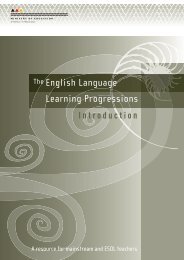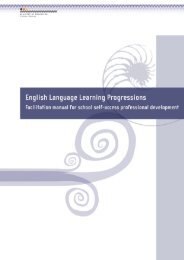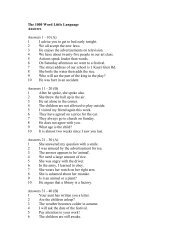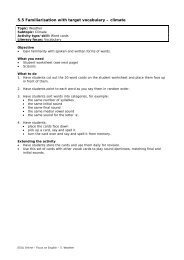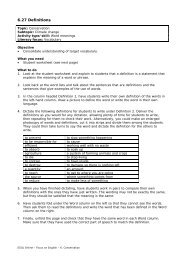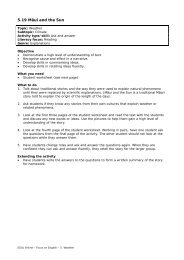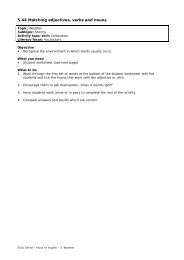ELLP Years1-4 - ESOL - Literacy Online - Te Kete Ipurangi
ELLP Years1-4 - ESOL - Literacy Online - Te Kete Ipurangi
ELLP Years1-4 - ESOL - Literacy Online - Te Kete Ipurangi
Create successful ePaper yourself
Turn your PDF publications into a flip-book with our unique Google optimized e-Paper software.
Introduction<br />
This booklet describes the learning pathways that learners in years 1–4 typically follow as they<br />
acquire an additional language (New Zealand English).<br />
English language learners in years 1–4 are usually between five and nine years of age. Learners<br />
in this group may have begun school in New Zealand at the age of five. They may have arrived<br />
in New Zealand when they were six, seven, eight, or nine, with or without previous experience of<br />
formal education (in English or in any other language). The English language level of learners in<br />
years 1–4 may be anywhere from the Foundation Stage to Stage 2 of the English Language Learning<br />
Progressions (<strong>ELLP</strong>), so this booklet includes examples of oral language, texts for reading, and<br />
learners’ writing that are appropriate for this age group at these three stages.<br />
<strong>Te</strong>achers’ expectations of an English language learner’s use of language need to be aligned with the<br />
individual’s developmental stage. <strong>Te</strong>achers’ expectations of progress should also take the learner’s<br />
stage of cognitive development into account.<br />
An English language learner’s level of English is usually related closely to their education levels<br />
in their first language and their previous English language learning. (There are also many other<br />
factors that affect a learner’s progress – see pages 6–8 of the introductory booklet for information<br />
about these.)<br />
As a group, English language learners in years 1–4 are closer in English proficiency to native<br />
speakers of the same age than are English language learners in later years. <strong>Te</strong>achers can, therefore,<br />
select or adapt resources that are designed for native speakers of English in years 1–4. This booklet<br />
can help you to decide how far to adapt the content of oral and written resources to personalise<br />
learning for your diverse learners (as recommended in Quality <strong>Te</strong>aching for Diverse Students in<br />
Schooling: Best Evidence Synthesis).<br />
It’s vital that the language-learning needs of learners in years 1–4 are diagnosed accurately so that<br />
they can get the kind of help they need. <strong>ESOL</strong> specialists (and other relevant specialists) should<br />
be involved in diagnosing each learner’s language-learning needs and in adapting the content of<br />
learning resources to meet these needs. You can look at some successful adaptations of content<br />
for English language learners in mainstream classes on <strong>ESOL</strong> <strong>Online</strong> (www.tki.org.nz/r/esol/<br />
esolonline/).<br />
It’s also important to reinforce the value of an English language learner’s first language. 1 Research<br />
shows that when a learner is encouraged to discuss concepts and tasks in their first language, their<br />
achievement is likely to be higher.<br />
This booklet is arranged into three sections: Oral Language, Reading, and Writing, each relevant<br />
to teachers of learners in years 1–4. It also includes a section with learning prompts that are<br />
appropriate for this age group. The Record of Progress form on page 64 allows teachers to record<br />
the progress of individual learners.<br />
1<br />
Although the term “first language” is commonly used in the singular, some learners may have more than one<br />
first language.<br />
3





